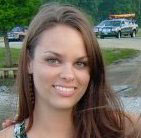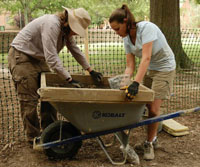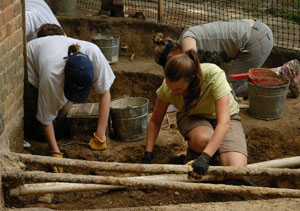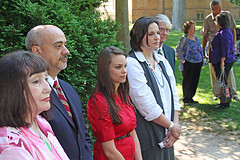Ashley Atkins Digs into Her Own History at Brafferton Site
Related Links:
- Uncovering Field School: Session Two
- Student Experience: Evan Rutherford '13
- Pre-excavation: Brafferton Indian Ceremony
- Learn More: The Brafferton Project

For Ashley Atkins, this summer’s Archaeological Field School experience was as personal as it was educational.
Six years after her first archaeological experience at William & Mary as a field school student, Ashley returned this summer as a teaching assistant to work on the excavation around the historic 1723 Brafferton, a building originally designed to house the College’s Indian School.
“It is interesting to come back and teach something I learned about not that long ago,” says Ashley. “Teaching has helped me better understand the experience of learning archaeology. It’s broadened my perspective that archaeology is more than just doing the work, it’s about working with the students and how we can work together.”
A member of the Pamunkey Indian Tribe, Ashley brought much more to the dig than the nuts-and-bolts instruction of archaeological field work. She brought personal knowledge of the culture the dig hopes to uncover. Ashley’s ancestors have a long history in the Tidewater region and many attended the school at the Brafferton. 
“I love doing archaeology for archaeology's sake,” says Ashley, a Ph.D. candidate in Anthropology at the College. “But much more than that, I literally have a familial connection to this dig. This is where Indian education began.”
As a child, Ashley maintained a strong connection to her heritage, spending most weekends and summers on the Pamunkey Indian Reservation in King William County near West Point. In college she discovered her passion for her future career.
“It was my sophomore year in college that I got interested in archaeology and Virginian Indian archaeology, specifically Pamunkey,” says Ashley who graduated from James Madison University in 2007 with a B.A. in anthropology. “Archaeology helps us learn more about our past and provides has the opportunity to learn more about the aspects of our past that may have been forgotten.”
Ashley’s research focus is on Virginia's Chesapeake Natives and material culture, specifically Pamunkey pottery and its importance in both historical and contemporary uses.
 “I’m researching the social significance of Pamunkey pottery and how it is viewed as a tradition and how that tradition is viewed by the Pamunkey,” says Ashley.
“I’m researching the social significance of Pamunkey pottery and how it is viewed as a tradition and how that tradition is viewed by the Pamunkey,” says Ashley.
Pottery was first made within Virginia Indian communities about 3,000 years ago. All of the pottery made today uses local clay from along the Pamunkey River banks on the Reservation. Some potters use the hand-built and open fired tradition handed down through generations. Another tradition was introduced in 1932 when the state of Virginia sponsored a pottery school on the Reservation to mass produce kiln fired pottery to meet the demands of the tourist market.
“Pottery for the Pamunkey is a marker for themselves and for the outside, non-Pamunkey world that they are a vibrant community that they want other Virginians to know still exists. I think pottery is a representation of that.” 
Ashley is the director/curator of the reservation’s Pamunkey Indian Museum and serves as a Native Advisor to the Department of Anthropology through the newly formed Brafferton Legacy Group. She sees archaeology as a tool to change perspectives on Indian history and culture. She believes the field is changing from a completely scientific, objective approach to a more subjective, humanistic understanding.
“We all bring our own assumptions and biases into our work,” says Ashley. “That’s why is has become more subjective. These are human beings, not just material objects, we are taking notes on.”
Ultimately Ashley hopes to put her experience and education to work for the Pamunkey tribe to help ensure that they have a hand in the protection and management of their cultural resources.
“I want to earn my Ph.D. so people will listen to me,” says Ashley who feels that all too often Native people are dismissed.
“My experience has come full circle,” she continues. “My grandfather always said ‘people in Virginia always forget the people in their own backyard,’ so I decided this is where my heart and head is, here in Virginia. Everything happens for a reason. I was meant to be here.”














